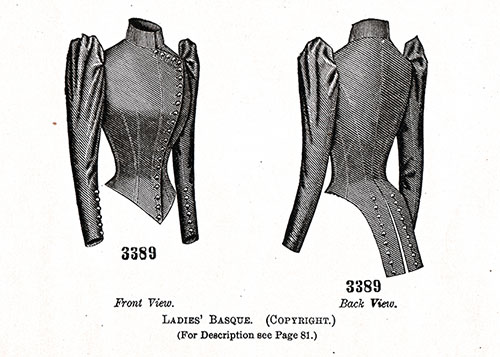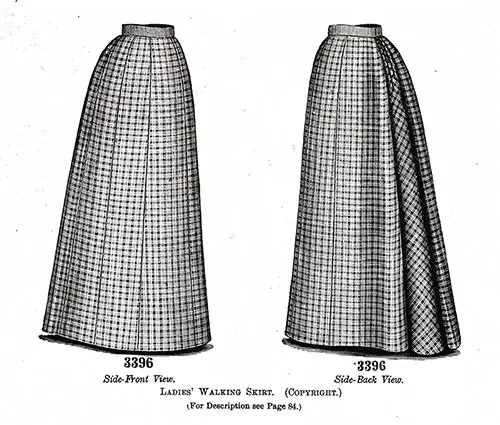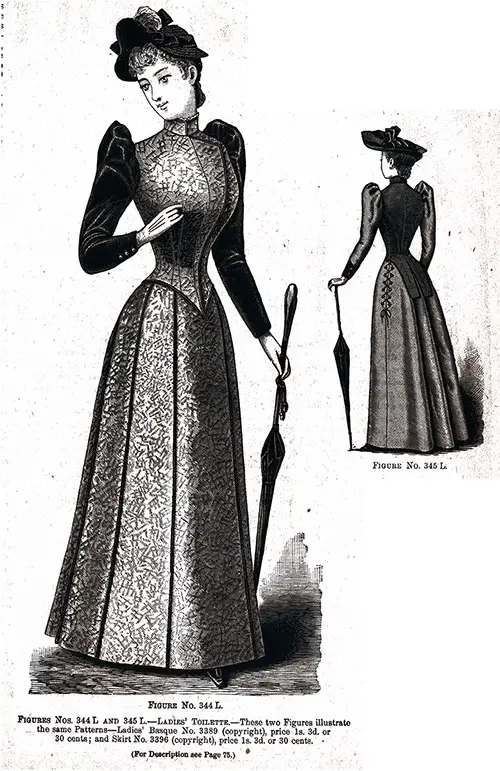Ladies Ensemble Dress 344 L and 345 L - 1890
Figure No. 344 L shows the costume developed in fancy suiting and black velvet, with black velvet cordings, small bone buttons and simulated button-holes of cord for decoration.
The front and sides of the skirt consist of five narrow gores and the back of three wide gores; the center gore at the back is bias and gathered at the top, and all the other gores are shaped to fit smoothly at the belt.
The back-gores fall in long, graceful rolling folds, which are made permanent by a lining of crinoline, an interlining of wadding and an ingenious arrangement of tapes underneath.
Cordings of velvet define the seams. The superb adjustment of the basque is accomplished by double bust darts, the customary gores, and a curving center seam.
The right front is widened by a lap that extends over the left side with diagonal effect, the closing being made with hooks and eyes. The lower outline of the basque describes a point at the front, and the back forms long coat-tails.
The full sleeves are of velvet arranged over coat-shaped linings; they rise high above the shoulders, and the wrists are finished with buttons and simulated button-holes. A. standing collar is at the neck. A cording of velvet finishes the edges of the basque.
The straw hat is trimmed with velvet ribbon and a pompon, and its brim is faced with velvet.
At figure No. 345 L is given a back view of the costume, showing it developed in Henrietta and corded silk in different shades of gray, and cord laced over buttons placed along the upper part of the front and side seams trim the skirt tastefully.
The sleeves are finished with fancy cuffs of the silk decorated at the back with buttons.
The straw hat has a flaring brim and is trimmed with stiff loops of ribbon.
Dressmaker Options
The mode will develop stylishly in all varieties of goods of silken or woolen texture. Braid, passementerie, galloon, lace, etc., may form the decoration and the method of application may be left to individual fancy.
Illustration and Pattern Information
Figures Nos. 344 L and 345 L.—These two figures illustrate the same patterns a Ladies’ costume, which consists of a basque and walking skirt.
The basque pattern, which is No. 3389 and costs Is. 3d. or 30 cents, is in thirteen sizes for ladies from twenty-eight to forty-six inches, bust measure, and is shown again on page 83.
The skirt pattern, which is No. 3396 and costs Is. 3d. or 30 cents, is in nine sizes for ladies from twenty to thirty-six inches, waist measure, and is illustrated differently on page 86.
Ladies' Basque Pattern No. 3389

No. 3389.—Other illustrations of this basque are given at figures Nos. 344 L and 345 L (above) in this Delineator, where it is shown differently made up and trimmed.
In the present instance, the basque is illustrated made of suit goods and decorated with gilt buttons. The adjustment is performed by double bust darts, under-arm and side-back gores, and a curving center seam that ends a little below the waist-line, forming the back into long, narrow coat-tails.
A diagonal effect is achieved by a lap joined by a curved seam to the right front, the lap being narrowed gradually toward the deep point described by the fronts at the center. Buttons and button-holes make the closing along the upper and front edges of the lap.
The sides arch high over the hips, and each side-back seam is decorated below the waist-line with a row of fancy gilt buttons. At the neck is a high standing collar.
The fancy sleeves are quite full above the elbow and fit smoothly below; they are arranged over a coat-shaped lining, and the fullness of each is regulated by a row of shirring at the top to produce the desired high effect above the shoulder.
A row of gilt buttons placed along the lower part of the inside seam provides a very stylish decoration.
Dressmaker Options
This basque was specially designed to be worn with walking skirt No. 3396, but, if preferred, any style of walking skirt may be substituted, and it may be made of the same kind of material as the basque or contrasting color and texture.
All sorts of dress fabrics will develop stylishly by the mode, and a stunning effect may be produced by making the sleeves of velvet.
Pattern Information
We have pattern No. 3389 in thirteen sizes for ladies from twenty-eight to forty-six inches, bust measure.
To make the garment for a lady of medium size will require three yards and a half of material twenty-two inches wide, or two yards and an-eighth thirty-six inches wide, or a yard and three-fourths, forty-four inches wide.
Price of pattern, 1s. 3d. or 30 cents.
Ladies’ Walking Skirt No. 3396

No. 3396.—Other illustrations of this skirt may be observed by referring to figures Nos. 344 L and 345 L (above) in this Delineator.
In the present instance, the skirt is represented made of checked cheviot. The front and sides consist of five narrow gores and the back of three wider gores, the middle gore at the back being cut bias and gathered at the top.
The three back gores are interlined with wadding, and all the parts are lined, the lining for the middle part of the back is cut straight instead of bias.
At each side of the center of the back is made a deep, backward-turning plait which conceals the seams nearest the back and rolls to the edge of the skirt, the middle gore also rolling with the effect of a pleat.
At the left side, a placket opening is made beneath the plait, and the fullness is held well to the back by two sets of tapes that are sewed underneath to the two seams nearest the center of the back at each side and tied together. The top is finished with a belt.
Dressmaker Options
The mode is adaptable to all varieties of plain or small-figured dress goods, cheviot being particularly well liked. The seams may all be decorated with a cording of the same or a contrasting material, with charming effect.
Silk made up in this way, with a cord of velvet inserted in each seam, will be very pretty. The crinoline and wadding will always be used, as the stylish effect of the back are lost without them.
The skirt is designed to be worn with basque No. 3389 (above), though any preferred style of basque may accompany it. The basque may be of the same or a different material from the skirt.
Pattern Information
We have pattern No. 3396 in nine sizes for ladies from twenty to thirty-six inches, waist measure.
For a lady of medium size, it will require seven yards and an-eighth of material twenty-two inches wide, or four yards and five-eighths thirty-six inches wide, or three yards and three-fourths forty-four inches wide, each with three yards and a-half of crinoline twenty-seven inches wide.
Price of pattern, 1s. 3d. or 30 cents.
“Figures Nos. 344 L and 345 L.—Ladies’ Toilette, “in The Delineator: A Journal of Fashion, Culture, and Fine Arts – Midsummer Number, New York: Butterick Publishing Co., Ltd, Vol. XXXVI, No. 2, August 1890, P. 75 (For Illustrations see Page 74.).
“Ladies' Basque [Pattern No. 3389], “in The Delineator: A Journal of Fashion, Culture, and Fine Arts – Midsummer Number, New York: Butterick Publishing Co., Ltd, Vol. XXXVI, No. 2, August 1890, P. 81 (For Illustrations see Page 83).
“Ladies’ Walking Skirt [No. 3396], “in The Delineator: A Journal of Fashion, Culture, and Fine Arts – Midsummer Number, New York: Butterick Publishing Co., Ltd, Vol. XXXVI, No. 2, August 1890, P. 84 (For Illustrations see Page 86).
Editor's Note: Some terminology used in the description of women's clothing during the 1800s and early 1900s has been changed to reflect more modern terms. For example, a women's "Toilette" -- a form of costume or outfit has an entirely different common meaning in the 21st century. Typical terms applied to "toilette" include outfit, ensemble, or costume, depending on context.
Note: We have edited this text to correct grammatical errors and improve word choice to clarify the article for today’s readers. Changes made are typically minor, and we often left passive text “as is.” Those who need to quote the article directly should verify any changes by reviewing the original material.

